[English] 日本語
 Yorodumi
Yorodumi- EMDB-64734: Macimorelin bound growth hormone secretagogue receptor in complex... -
+ Open data
Open data
- Basic information
Basic information
| Entry |  | ||||||||||||
|---|---|---|---|---|---|---|---|---|---|---|---|---|---|
| Title | Macimorelin bound growth hormone secretagogue receptor in complex with Gq | ||||||||||||
 Map data Map data | |||||||||||||
 Sample Sample |
| ||||||||||||
 Keywords Keywords | Macimorelin / growth hormone secretagogue receptor / GHSR / GPCR / MEMBRANE PROTEIN/IMMUNE SYSTEM / MEMBRANE PROTEIN-IMMUNE SYSTEM complex | ||||||||||||
| Function / homology |  Function and homology information Function and homology informationgrowth hormone secretagogue receptor activity / regulation of hindgut contraction / regulation of growth hormone secretion / positive regulation of small intestinal transit / negative regulation of locomotion involved in locomotory behavior / growth hormone-releasing hormone receptor activity / regulation of gastric motility / response to follicle-stimulating hormone / regulation of transmission of nerve impulse / ghrelin secretion ...growth hormone secretagogue receptor activity / regulation of hindgut contraction / regulation of growth hormone secretion / positive regulation of small intestinal transit / negative regulation of locomotion involved in locomotory behavior / growth hormone-releasing hormone receptor activity / regulation of gastric motility / response to follicle-stimulating hormone / regulation of transmission of nerve impulse / ghrelin secretion / positive regulation of appetite / growth hormone secretion / negative regulation of norepinephrine secretion / positive regulation of small intestine smooth muscle contraction / negative regulation of macrophage apoptotic process / positive regulation of eating behavior / adult feeding behavior / negative regulation of appetite / actin polymerization or depolymerization / positive regulation of multicellular organism growth / cellular response to thyroid hormone stimulus / response to growth hormone / regulation of postsynapse organization / positive regulation of insulin-like growth factor receptor signaling pathway / response to L-glutamate / positive regulation of vascular endothelial cell proliferation / negative regulation of interleukin-1 beta production / response to food / positive regulation of fatty acid metabolic process / response to dexamethasone / cellular response to insulin-like growth factor stimulus / regulation of synapse assembly / positive regulation of sprouting angiogenesis / regulation of neurotransmitter receptor localization to postsynaptic specialization membrane / decidualization / peptide hormone binding / negative regulation of interleukin-6 production / negative regulation of tumor necrosis factor production / postsynaptic modulation of chemical synaptic transmission / response to hormone / hormone-mediated signaling pathway / insulin-like growth factor receptor signaling pathway / synaptic membrane / Peptide ligand-binding receptors / negative regulation of insulin secretion / electron transport chain / G protein-coupled receptor activity / negative regulation of inflammatory response / Schaffer collateral - CA1 synapse / Olfactory Signaling Pathway / Activation of the phototransduction cascade / cellular response to insulin stimulus / G beta:gamma signalling through PLC beta / Presynaptic function of Kainate receptors / Thromboxane signalling through TP receptor / G protein-coupled acetylcholine receptor signaling pathway / Activation of G protein gated Potassium channels / Inhibition of voltage gated Ca2+ channels via Gbeta/gamma subunits / G-protein activation / Prostacyclin signalling through prostacyclin receptor / G beta:gamma signalling through CDC42 / Glucagon signaling in metabolic regulation / G beta:gamma signalling through BTK / Synthesis, secretion, and inactivation of Glucagon-like Peptide-1 (GLP-1) / ADP signalling through P2Y purinoceptor 12 / photoreceptor disc membrane / Sensory perception of sweet, bitter, and umami (glutamate) taste / Glucagon-type ligand receptors / Adrenaline,noradrenaline inhibits insulin secretion / Vasopressin regulates renal water homeostasis via Aquaporins / Glucagon-like Peptide-1 (GLP1) regulates insulin secretion / G alpha (z) signalling events / cellular response to catecholamine stimulus / ADORA2B mediated anti-inflammatory cytokines production / ADP signalling through P2Y purinoceptor 1 / G beta:gamma signalling through PI3Kgamma / adenylate cyclase-activating dopamine receptor signaling pathway / Cooperation of PDCL (PhLP1) and TRiC/CCT in G-protein beta folding / response to estradiol / GPER1 signaling / Inactivation, recovery and regulation of the phototransduction cascade / cellular response to prostaglandin E stimulus / G-protein beta-subunit binding / heterotrimeric G-protein complex / G alpha (12/13) signalling events / sensory perception of taste / extracellular vesicle / signaling receptor complex adaptor activity / Thrombin signalling through proteinase activated receptors (PARs) / retina development in camera-type eye / cellular response to lipopolysaccharide / GTPase binding / Ca2+ pathway / fibroblast proliferation / High laminar flow shear stress activates signaling by PIEZO1 and PECAM1:CDH5:KDR in endothelial cells / spermatogenesis / G alpha (i) signalling events / G alpha (s) signalling events / phospholipase C-activating G protein-coupled receptor signaling pathway / G alpha (q) signalling events Similarity search - Function | ||||||||||||
| Biological species |  Homo sapiens (human) / Homo sapiens (human) /   | ||||||||||||
| Method | single particle reconstruction / cryo EM / Resolution: 2.63 Å | ||||||||||||
 Authors Authors | Wang R / Sun J / Liu H / Guo S / Zhang Y / Hu W / Wang J / Zhuang Y / Jiang Y / Xie X ...Wang R / Sun J / Liu H / Guo S / Zhang Y / Hu W / Wang J / Zhuang Y / Jiang Y / Xie X / Xu H / Wang Y | ||||||||||||
| Funding support |  China, 3 items China, 3 items
| ||||||||||||
 Citation Citation |  Journal: Acta Pharmacol Sin / Year: 2025 Journal: Acta Pharmacol Sin / Year: 2025Title: Molecular recognition of two approved drugs Macimorelin and Anamorelin by the growth hormone secretagogue receptor. Authors: Ruo-Lan Wang / Jun Sun / Heng Liu / Shi-Meng Guo / Yu Zhang / Wen Hu / Jiang Wang / Hong Liu / You-Wen Zhuang / Yi Jiang / Xin Xie / H Eric Xu / Yue Wang /  Abstract: The growth hormone secretagogue receptor (GHSR) plays a critical role in regulating growth hormone release and metabolic homeostasis. Understanding the molecular mechanisms of ligand-GHSR recognition ...The growth hormone secretagogue receptor (GHSR) plays a critical role in regulating growth hormone release and metabolic homeostasis. Understanding the molecular mechanisms of ligand-GHSR recognition is essential for developing therapeutic interventions. In this study, we investigated the molecular recognition mechanisms of two clinically approved drugs: Macimorelin (used for diagnosing adult growth hormone deficiency) and Anamorelin (approved in Japan for cancer cachexia). Using high-resolution cryo-electron microscopy, we determined the structures of GHSR bound to Macimorelin and Anamorelin in complex with G proteins at resolutions of 2.63 Å and 2.52 Å, respectively. We revealed that both drugs occupied a bifurcated binding pocket divided by a conserved salt bridge between E124 and R283. Through systematic mutagenesis and functional studies, we identified the key residues underlying the higher binding affinity of Anamorelin compared to Macimorelin. In addition, structural comparison of GHSR in complex with different G protein subtypes elucidated the mechanisms driving G protein selectivity. Our results provide crucial insights into GHSR-drug interactions and offer valuable guidance for designing more selective and potent GHSR agonists. | ||||||||||||
| History |
|
- Structure visualization
Structure visualization
| Supplemental images |
|---|
- Downloads & links
Downloads & links
-EMDB archive
| Map data |  emd_64734.map.gz emd_64734.map.gz | 59.7 MB |  EMDB map data format EMDB map data format | |
|---|---|---|---|---|
| Header (meta data) |  emd-64734-v30.xml emd-64734-v30.xml emd-64734.xml emd-64734.xml | 23 KB 23 KB | Display Display |  EMDB header EMDB header |
| FSC (resolution estimation) |  emd_64734_fsc.xml emd_64734_fsc.xml | 8.4 KB | Display |  FSC data file FSC data file |
| Images |  emd_64734.png emd_64734.png | 48.2 KB | ||
| Filedesc metadata |  emd-64734.cif.gz emd-64734.cif.gz | 7.3 KB | ||
| Others |  emd_64734_half_map_1.map.gz emd_64734_half_map_1.map.gz emd_64734_half_map_2.map.gz emd_64734_half_map_2.map.gz | 59.4 MB 59.4 MB | ||
| Archive directory |  http://ftp.pdbj.org/pub/emdb/structures/EMD-64734 http://ftp.pdbj.org/pub/emdb/structures/EMD-64734 ftp://ftp.pdbj.org/pub/emdb/structures/EMD-64734 ftp://ftp.pdbj.org/pub/emdb/structures/EMD-64734 | HTTPS FTP |
-Validation report
| Summary document |  emd_64734_validation.pdf.gz emd_64734_validation.pdf.gz | 1 MB | Display |  EMDB validaton report EMDB validaton report |
|---|---|---|---|---|
| Full document |  emd_64734_full_validation.pdf.gz emd_64734_full_validation.pdf.gz | 1 MB | Display | |
| Data in XML |  emd_64734_validation.xml.gz emd_64734_validation.xml.gz | 16.5 KB | Display | |
| Data in CIF |  emd_64734_validation.cif.gz emd_64734_validation.cif.gz | 21.5 KB | Display | |
| Arichive directory |  https://ftp.pdbj.org/pub/emdb/validation_reports/EMD-64734 https://ftp.pdbj.org/pub/emdb/validation_reports/EMD-64734 ftp://ftp.pdbj.org/pub/emdb/validation_reports/EMD-64734 ftp://ftp.pdbj.org/pub/emdb/validation_reports/EMD-64734 | HTTPS FTP |
-Related structure data
| Related structure data |  9v2nMC  9uy3C M: atomic model generated by this map C: citing same article ( |
|---|---|
| Similar structure data | Similarity search - Function & homology  F&H Search F&H Search |
- Links
Links
| EMDB pages |  EMDB (EBI/PDBe) / EMDB (EBI/PDBe) /  EMDataResource EMDataResource |
|---|---|
| Related items in Molecule of the Month |
- Map
Map
| File |  Download / File: emd_64734.map.gz / Format: CCP4 / Size: 64 MB / Type: IMAGE STORED AS FLOATING POINT NUMBER (4 BYTES) Download / File: emd_64734.map.gz / Format: CCP4 / Size: 64 MB / Type: IMAGE STORED AS FLOATING POINT NUMBER (4 BYTES) | ||||||||||||||||||||||||||||||||||||
|---|---|---|---|---|---|---|---|---|---|---|---|---|---|---|---|---|---|---|---|---|---|---|---|---|---|---|---|---|---|---|---|---|---|---|---|---|---|
| Projections & slices | Image control
Images are generated by Spider. | ||||||||||||||||||||||||||||||||||||
| Voxel size | X=Y=Z: 0.73 Å | ||||||||||||||||||||||||||||||||||||
| Density |
| ||||||||||||||||||||||||||||||||||||
| Symmetry | Space group: 1 | ||||||||||||||||||||||||||||||||||||
| Details | EMDB XML:
|
-Supplemental data
-Half map: #1
| File | emd_64734_half_map_1.map | ||||||||||||
|---|---|---|---|---|---|---|---|---|---|---|---|---|---|
| Projections & Slices |
| ||||||||||||
| Density Histograms |
-Half map: #2
| File | emd_64734_half_map_2.map | ||||||||||||
|---|---|---|---|---|---|---|---|---|---|---|---|---|---|
| Projections & Slices |
| ||||||||||||
| Density Histograms |
- Sample components
Sample components
-Entire : Macimorelin bound growth hormone secretagogue receptor in complex...
| Entire | Name: Macimorelin bound growth hormone secretagogue receptor in complex with Gq |
|---|---|
| Components |
|
-Supramolecule #1: Macimorelin bound growth hormone secretagogue receptor in complex...
| Supramolecule | Name: Macimorelin bound growth hormone secretagogue receptor in complex with Gq type: complex / ID: 1 / Parent: 0 / Macromolecule list: #1-#6 |
|---|---|
| Source (natural) | Organism:  Homo sapiens (human) Homo sapiens (human) |
-Macromolecule #1: Engineered G-alpha-q subunit
| Macromolecule | Name: Engineered G-alpha-q subunit / type: protein_or_peptide / ID: 1 / Number of copies: 1 / Enantiomer: LEVO |
|---|---|
| Source (natural) | Organism:  Homo sapiens (human) Homo sapiens (human) |
| Molecular weight | Theoretical: 41.855578 KDa |
| Recombinant expression | Organism:  |
| Sequence | String: MMGCTLSAED KAAVERSKMI EKQLQKDKQV YRRTLRLLLL GADNSGKSTI VKQMRIYHVN GYSEEECKQY KAVVYSNTIQ SIIAIIRAM GRLKIDFGDS ARADDARQLF VLAGAAEEGF MTAELAGVIK RLWKDSGVQA CFNRSREYQL NDSAAYYLND L DRIAQPNY ...String: MMGCTLSAED KAAVERSKMI EKQLQKDKQV YRRTLRLLLL GADNSGKSTI VKQMRIYHVN GYSEEECKQY KAVVYSNTIQ SIIAIIRAM GRLKIDFGDS ARADDARQLF VLAGAAEEGF MTAELAGVIK RLWKDSGVQA CFNRSREYQL NDSAAYYLND L DRIAQPNY IPTQQDVLRT RVKTSGIFET KFQVDKVNFH MFDVGAQRDE RRKWIQCFND VTAIIFVVDS SDYNRLQEAL ND FKSIWNN RWLRTISVIL FLNKQDLLAE KVLAGKSKIE DYFPEFARYT TPEDATPEPG EDPRVTRAKY FIRKEFVDIS TAS GDGRHI CYPHFTCSVD TENARRIFND CKDIILQMNL REYNLV |
-Macromolecule #2: Guanine nucleotide-binding protein G(I)/G(S)/G(T) subunit beta-1
| Macromolecule | Name: Guanine nucleotide-binding protein G(I)/G(S)/G(T) subunit beta-1 type: protein_or_peptide / ID: 2 / Number of copies: 1 / Enantiomer: LEVO |
|---|---|
| Source (natural) | Organism:  Homo sapiens (human) Homo sapiens (human) |
| Molecular weight | Theoretical: 40.226992 KDa |
| Recombinant expression | Organism:  |
| Sequence | String: MGSLLQSELD QLRQEAEQLK NQIRDARKAC ADATLSQITN NIDPVGRIQM RTRRTLRGHL AKIYAMHWGT DSRLLVSASQ DGKLIIWDS YTTNKVHAIP LRSSWVMTCA YAPSGNYVAC GGLDNICSIY NLKTREGNVR VSRELAGHTG YLSCCRFLDD N QIVTSSGD ...String: MGSLLQSELD QLRQEAEQLK NQIRDARKAC ADATLSQITN NIDPVGRIQM RTRRTLRGHL AKIYAMHWGT DSRLLVSASQ DGKLIIWDS YTTNKVHAIP LRSSWVMTCA YAPSGNYVAC GGLDNICSIY NLKTREGNVR VSRELAGHTG YLSCCRFLDD N QIVTSSGD TTCALWDIET GQQTTTFTGH TGDVMSLSLA PDTRLFVSGA CDASAKLWDV REGMCRQTFT GHESDINAIC FF PNGNAFA TGSDDATCRL FDLRADQELM TYSHDNIICG ITSVSFSKSG RLLLAGYDDF NCNVWDALKA DRAGVLAGHD NRV SCLGVT DDGMAVATGS WDSFLKIWNG SSGGGGSGGG GSSGVSGWRL FKKIS UniProtKB: Guanine nucleotide-binding protein G(I)/G(S)/G(T) subunit beta-1 |
-Macromolecule #3: Guanine nucleotide-binding protein G(I)/G(S)/G(O) subunit gamma-2
| Macromolecule | Name: Guanine nucleotide-binding protein G(I)/G(S)/G(O) subunit gamma-2 type: protein_or_peptide / ID: 3 / Number of copies: 1 / Enantiomer: LEVO |
|---|---|
| Source (natural) | Organism:  Homo sapiens (human) Homo sapiens (human) |
| Molecular weight | Theoretical: 7.861143 KDa |
| Recombinant expression | Organism:  |
| Sequence | String: MASNNTASIA QARKLVEQLK MEANIDRIKV SKAAADLMAY CEAHAKEDPL LTPVPASENP FREKKFFCAI L UniProtKB: Guanine nucleotide-binding protein G(I)/G(S)/G(O) subunit gamma-2 |
-Macromolecule #4: NB35
| Macromolecule | Name: NB35 / type: protein_or_peptide / ID: 4 / Number of copies: 1 / Enantiomer: LEVO |
|---|---|
| Source (natural) | Organism:  |
| Molecular weight | Theoretical: 15.343019 KDa |
| Recombinant expression | Organism:  Escherichia phage EcSzw-2 (virus) Escherichia phage EcSzw-2 (virus) |
| Sequence | String: MAQVQLQESG GGLVQPGGSL RLSCAASGFT FSNYKMNWVR QAPGKGLEWV SDISQSGASI SYTGSVKGRF TISRDNAKNT LYLQMNSLK PEDTAVYYCA RCPAPFTRDC FDVTSTTYAY RGQGTQVTVS SHHHHHHEPE A |
-Macromolecule #5: Soluble cytochrome b562,Growth hormone secretagogue receptor type...
| Macromolecule | Name: Soluble cytochrome b562,Growth hormone secretagogue receptor type 1,growth hormone secretagogue receptor type: protein_or_peptide / ID: 5 / Number of copies: 1 / Enantiomer: LEVO |
|---|---|
| Source (natural) | Organism:  Homo sapiens (human) Homo sapiens (human) |
| Molecular weight | Theoretical: 76.149734 KDa |
| Recombinant expression | Organism:  |
| Sequence | String: MKTIIALSYI FCLVFAHHHH HHHHHHPSRL EEELRRRLTE PADLEDNWET LNDNLKVIEK ADNAAQVKDA LTKMRAAALD AQKATPPKL EDKSPDSPEM KDFRHGFDIL VGQIDDALKL ANEGKVKEAQ AAAEQLKTTR NAYIQKYLMW NATPSEEPGF N LTLADLDW ...String: MKTIIALSYI FCLVFAHHHH HHHHHHPSRL EEELRRRLTE PADLEDNWET LNDNLKVIEK ADNAAQVKDA LTKMRAAALD AQKATPPKL EDKSPDSPEM KDFRHGFDIL VGQIDDALKL ANEGKVKEAQ AAAEQLKTTR NAYIQKYLMW NATPSEEPGF N LTLADLDW DASPGNDSLG DELLQLFPAP LLAGVTATCV ALFVVGIAGN LLTMLVVSRF RELRTTTNLY LSSMAFSDLL IF LCMPLDL VRLWQYRPWN FGDLLCKLFQ FVSESCTYAT VLTITALSVE RYFAICFPLR AKVVVTKGRV KLVIFVIWAV AFC SAGPIF VLVGVEHENG TDPWDTNECR PTEFAVRSGL LTVMVWVSSI FFFLPVFCLT VLYSLIGRKL WRRRRGDAVV GASL RDQNH KQTVKMLAVV VFAFILCWLP FHVGRYLFSK SFEPGSLEIA QISQYCNLVS FVLFYLSAAI NPILYNIMSK KYRVA VFRL LGFEPFSQRK LSTLKDESSR AWTESSINTG SAGSVFTLED FVGDWEQTAA YNLDQVLEQG GVSSLLQNLA VSVTPI QRI VRSGENALKI DIHVIIPYEG LSADQMAQIE EVFKVVYPVD DHHFKVILPY GTLVIDGVTP NMLNYFGRPY EGIAVFD GK KITVTGTLWN GNKIIDERLI TPDGSMLFRV TINS UniProtKB: Soluble cytochrome b562, Growth hormone secretagogue receptor type 1 |
-Macromolecule #6: scFv16
| Macromolecule | Name: scFv16 / type: protein_or_peptide / ID: 6 / Number of copies: 1 / Enantiomer: LEVO |
|---|---|
| Source (natural) | Organism:  |
| Molecular weight | Theoretical: 32.561281 KDa |
| Recombinant expression | Organism:  |
| Sequence | String: LLVNQSHQGF NKEHTSKMVS AIVLYVLLAA AAHSAFAVQL VESGGGLVQP GGSRKLSCSA SGFAFSSFGM HWVRQAPEKG LEWVAYISS GSGTIYYADT VKGRFTISRD DPKNTLFLQM TSLRSEDTAM YYCVRSIYYY GSSPFDFWGQ GTTLTVSAGG G GSGGGGSG ...String: LLVNQSHQGF NKEHTSKMVS AIVLYVLLAA AAHSAFAVQL VESGGGLVQP GGSRKLSCSA SGFAFSSFGM HWVRQAPEKG LEWVAYISS GSGTIYYADT VKGRFTISRD DPKNTLFLQM TSLRSEDTAM YYCVRSIYYY GSSPFDFWGQ GTTLTVSAGG G GSGGGGSG GGGSADIVMT QATSSVPVTP GESVSISCRS SKSLLHSNGN TYLYWFLQRP GQSPQLLIYR MSNLASGVPD RF SGSGSGT AFTLTISRLE AEDVGVYYCM QHLEYPLTFG AGTKLELVDE NLYFQGASHH HHHHHH |
-Macromolecule #7: Macimorelin
| Macromolecule | Name: Macimorelin / type: ligand / ID: 7 / Number of copies: 1 / Formula: A1EQV |
|---|---|
| Molecular weight | Theoretical: 474.555 Da |
-Experimental details
-Structure determination
| Method | cryo EM |
|---|---|
 Processing Processing | single particle reconstruction |
| Aggregation state | particle |
- Sample preparation
Sample preparation
| Buffer | pH: 7.3 |
|---|---|
| Vitrification | Cryogen name: ETHANE |
- Electron microscopy
Electron microscopy
| Microscope | FEI TALOS ARCTICA |
|---|---|
| Image recording | Film or detector model: FEI FALCON IV (4k x 4k) / Average electron dose: 50.0 e/Å2 |
| Electron beam | Acceleration voltage: 300 kV / Electron source: OTHER |
| Electron optics | Illumination mode: OTHER / Imaging mode: OTHER / Nominal defocus max: 2.0 µm / Nominal defocus min: 1.0 µm |
| Experimental equipment | 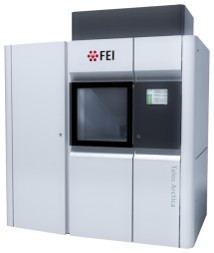 Model: Talos Arctica / Image courtesy: FEI Company |
 Movie
Movie Controller
Controller





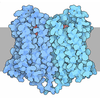


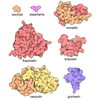
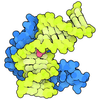
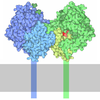

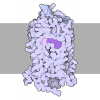











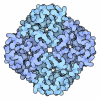
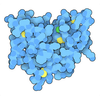




 Z (Sec.)
Z (Sec.) Y (Row.)
Y (Row.) X (Col.)
X (Col.)






































